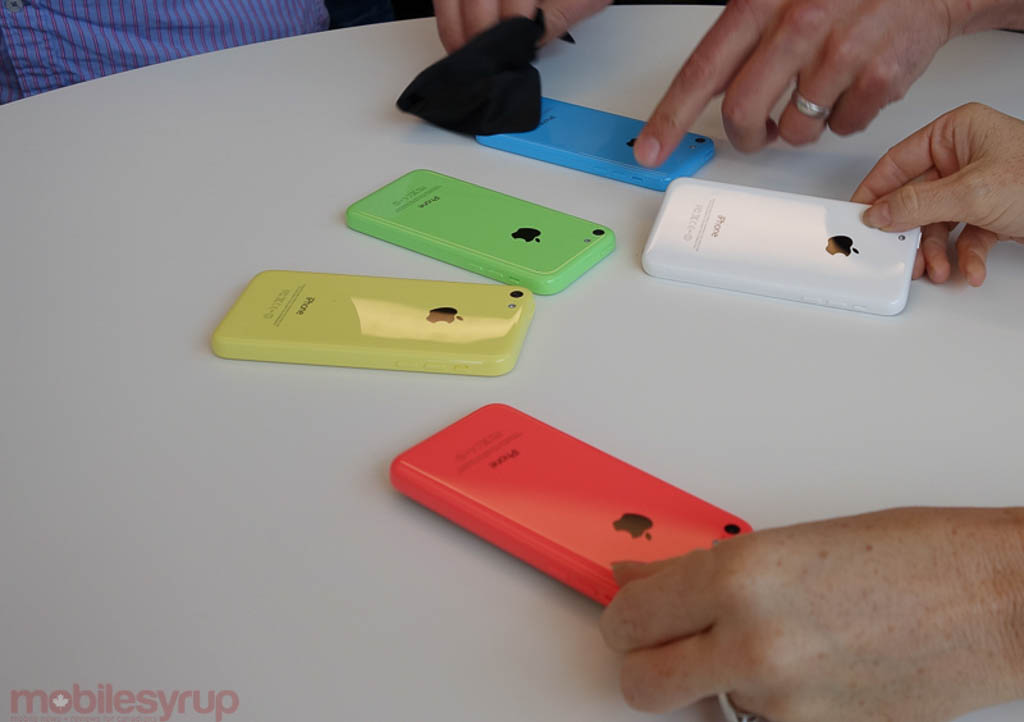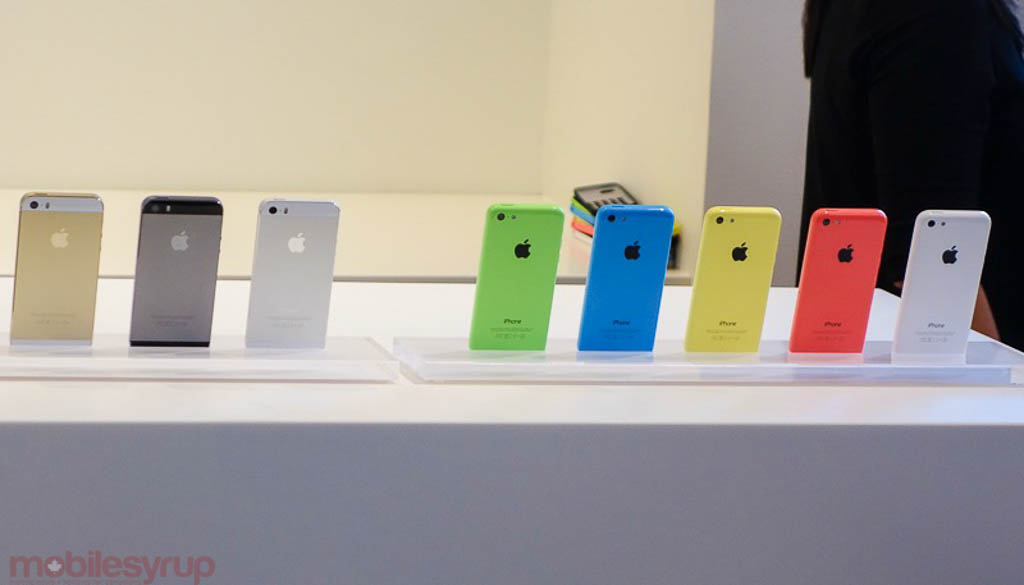
Apple’s annual iPhone event yesterday may have left some wondering why the company announced two smartphones, and fuller minds than mine will write about the marginal savings in manufacturing costs, but it’s clear Apple’s two-pronged approach is meant to mete out as much marketing muscle as humanly (or digitally) possible.
With the co-introduction of the iPhone 5c, which starts at $99, and the iPhone 5S, which costs $100 more, Apple is finally adding variety to a product line that dealt retailers, carriers and itself a hand of hand-me-downs for too many years. They did the same last year with the iPad mini, and have been serving iPods nano alongside iPods touch for years — now it’s come to the company’s most profitable product.
iPhone 5c
I recently claimed the perfect smartphone is close, leading to slower growth and fewer sales at the high-end of the market. This notion was reinforced yesterday when Apple announced the iPhone 5c, a colourful repackaging of last year’s iPhone 5 hardware.
While it was widely believed Apple would launch a low-cost variant of its iPhone 5, the actual pricing confirms that Cupertino is largely maintaining the status quo, offering the entry-level product for $99 on a 2-year term and $599 when purchased outright. This is the cheapest “new” iPhone released to date, but if Apple had chosen to do the same as previous years, discounting the previous model $100 and leaving it on store shelves, there would be little, if any, variation in price.
To whit, the iPhone 5c is not so much a new iPhone as a new marketing opportunity, a way for Apple to sell millions of colourful steel-reinforced polycarbonate shells to those reaching the end of their iPhone 4 and 4S commitments. The iPhone 5c is not for iPhone 5 users: they are basically the same phone.
Bedecked in blue, red, yellow green or white, however, the iPhone 5c is the iPod touch for a generation moving beyond music players. Internally, the iPhone 5c is every bit a modern phone, and no one would dare call the iPhone 5, on which it is largely based, slow. Apple’s lead designer, Jony Ive, noted that the 5c’s software is every bit as important as the hardware, and that each shade comes with a complementary iOS 7 wallpaper speaks to that.
Today, the 16GB iPhone 5 is $199 on a 2-year contract; the 32GB model is $299. On September 20th, that price, for all intents and purposes, will drop to $99 and $199 respectively. For many smartphone shoppers, the 32GB iPhone 5c will be the best choice for well-made hardware, a mature and comprehensive app ecosystem, a smooth operating system, a fast camera and decent battery life. That its “hard-coated polycarbonate” chassis and consolidated SKU with an impressive number of LTE bands saves Apple money and increases their margins can’t go unsaid, either.
For many of our readers the iPhone 5c is not exciting, but you better believe, arrayed in its varied blushes of colour, it will be exciting to shoppers. It’s also important to note that at a $99 entry price is competitive with other year-old devices; the Samsung Galaxy Mega, Note II and S3 are all $99 at Rogers, along with the Xperia ZL. Users will see, for all intents and purposes, a new phone for the same price when they walk into stores.
iPhone 5S
To me, the iPhone 5S is by far the more interesting product. Though it resembles the iPhone 5 on the outside (but for the updated Space Grey colour and new gold model), the “tock” year of Apple’s iPhone announcements (think 3GS, 4S and now 5S) packs internal improvements that substantively — and substantially — improve the user experience. Say what you will about iOS as a platform — and I’m sure you will — but there is no question of Apple’s continued superiority in sourcing parts and building structurally sound phones.
I’ll admit to being disappointed by a few aspects of the iPhone 5S. Aside from the screen size, which Apple doesn’t seem to be in a rush to change (for multiple reasons: read this excellent iMore article for more), it was unfortunate that Apple neglected to add Wireless-AC to the iPhone 5S. This incoming spec, which supports speeds above a gigabit per second, comes standard on many Android devices thanks to a proliferation of modern Qualcomm basebands. It appears as though Apple is using a variation of last year’s iPhone 5 baseband, which opens up more LTE networks but adds little to the overall connectivity strategy.
Rogers users will also be disappointed to learn that neither the iPhone 5S nor the 5c support Band VII 2600Mhz, also known as LTE Max, so they won’t be able to advantage of those ultra-fast speeds seen on the Moto X and Galaxy S4. This omission is interesting largely because the iPhone 5S (and the 5c) support nearly every other LTE band in use today (Bands 1, 2, 3, 4, 5, 8, 13, 17, 19, 20, 25), but only up to 100Mbps. Either Qualcomm’s next-generation standalone baseband wasn’t ready for distribution by the time Apple finalized its parts, or they felt it wasn’t a necessary inclusion this time around.
But the iPhone 5S impresses where it counts: the harmonious amalgamation of specs and features.
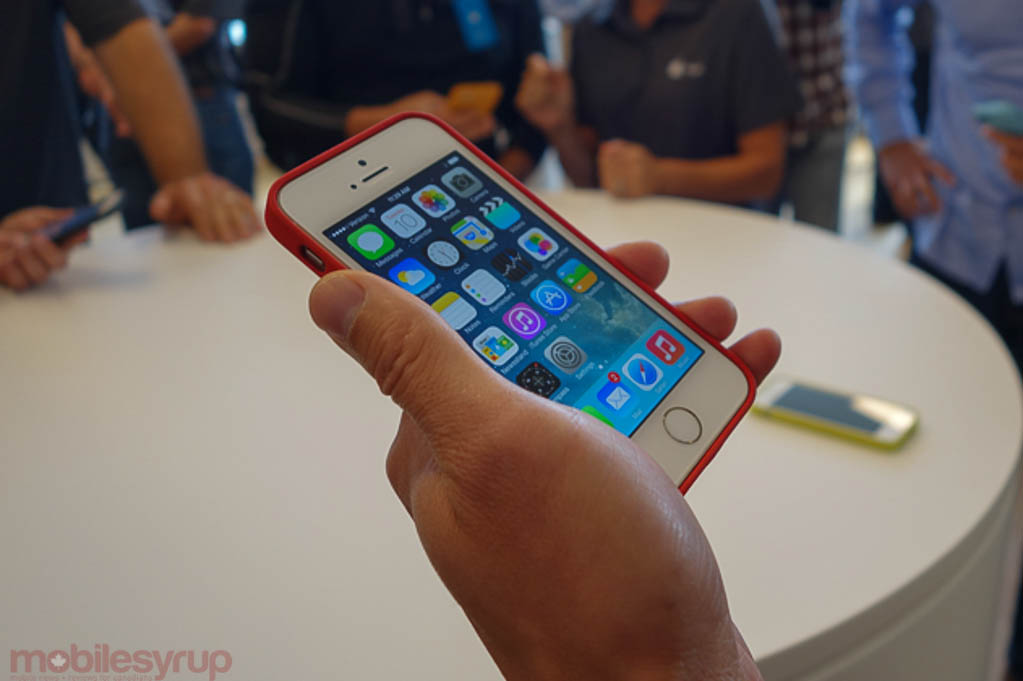
The A7 chip, which takes the company’s custom-made Swift architecture and expands it to a 64-bit architecture, is impressive not only because it is the first of its kind in a smartphone, but because the A6 was neither hurting for bandwidth nor lacking in capabilities. The A7 may turn out to be faster than Qualcomm’s Snapdragon 800 processor in CPU performance, and will almost certainly outclass it in the GPU department. Those who think of the iPhone as a mid-range device merely because it contains only two CPU cores merely have to look at the Moto X for proof of their folly.
According to Kerry Morrison, CEO of Toronto-based Endloop Mobile, a multi-platform app development shop, the move to 64-bit may not impact consumers right away, but it gives developers more headroom to work with in games that push high-resolution textures and wide-bandwidth memory. “It’s about squeezing every last bit of performance,” he said. Apple is not necessitating that developers switch over their apps to 64-bit right away, either, as both 32-bit and 64-bit versions will be supported simultaneously. This is not the Intel/AMD mess of the early 2000’s all over again.
Apple also announced the M7 to work in conjunction with the A7, another inclusion of which we’ve seen something similar in the Moto X. The M7 is an ultra low-power chip that constantly reads accelerometer, compass and gyroscope readings from the iPhone 5S, which can in turn be provided to a fitness or GPS app. Apple is clearly taking on companies like Jawbone and Fitbit, as well as partner Nike’s Fuel Band, by allowing developers access to all this data, even when the app isn’t open. While it may not be comfortable to sleep with an iPhone next to your head — a Fitbit Flex or Jawbone UP still wins in that department — I can see data from the M7 being used to augment existing apps like Runtastic and Fitocracy, which aim to encourage users to be as active as possible. M7 promises to provide this data to apps without eating into battery life, something that can’t be said for Samsung’s S Health, which engages one of its cores at all times to accrue similar information.
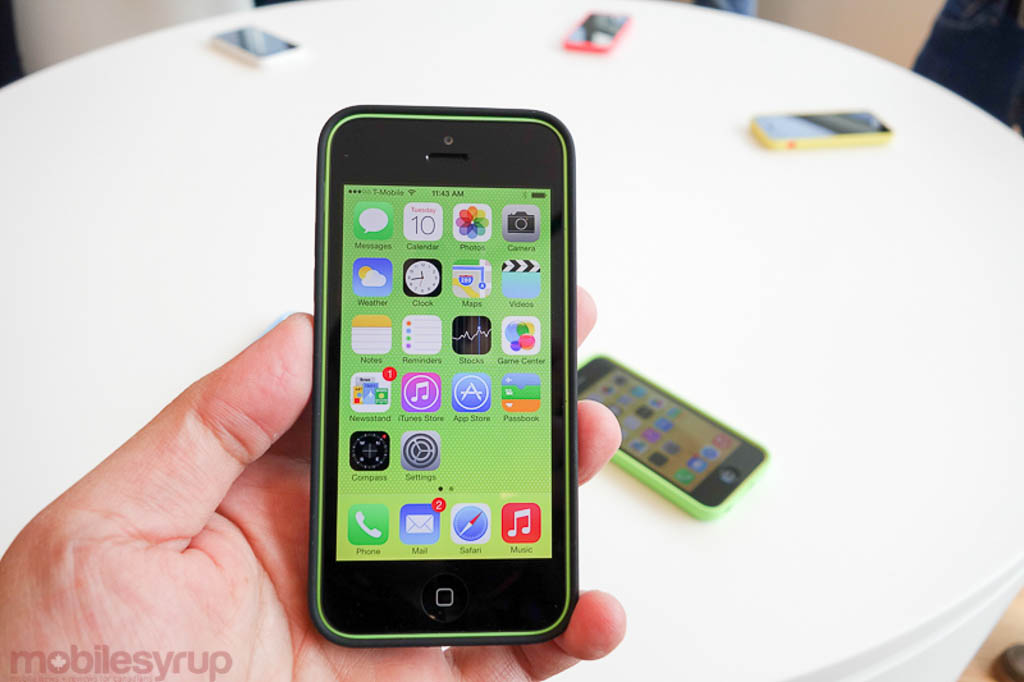
Many of the iPhone 5S’ more iterative updates, like the extra two hours of battery life, and a 15% larger camera sensor and new f/2.2 aperture, may not sound like a lot on paper, but they add up to a considerable improvement. We’ve yet to play with the final build of iOS 7, but the iPhone 5 still beats out 90% of the Android market in battery life with a cell half the size. And the iPhone 5’s camera is still, even after the launch of the HTC One, Galaxy S4, Xperia Z, Lumia 920 and others, one of the best on the market. It’s also one of the most consistent; in contrast, the Moto X can capture some incredible photos, but it almost always spits out a few duds thereafter. Features like Burst Mode and Slo-Mo may not be new to the industry — high-end Android phones, along with the latest Lumia devices have been offering the feature for years — but they’re well-implemented. For example, the HTC One has a pretty great multi-shot mode, but its camera app only allows you to save one photo from the bunch. Similarly, the iPhone 5S’ Slo-Mo mode lets you edit portions of the video within the app right after filming. These may not be innovations, but they’re implemented with an alacrity that many Android OEMs lack.
The iPhone 5S also includes a biometric fingerprint scanner that, combined with a passcode, has the potential to, yes, more quickly unlock devices, but also engage with payment services in ways that other phone manufacturers haven’t been able to with NFC. Apple still doesn’t believe NFC has a place in its products, and has shunned an emerging technology that most others, from BlackBerry to Samsung to Nokia, have wholly embraced. Sony may be the finest example of a company uniting its product lines with NFC; Apple chooses to do so with Bluetooth LE and, potentially, the scanner built into its iPhone 5S home button.
Developers won’t initially be allowed to plug into that data, and security experts are wavering over whether there are holes Apple has left unplugged, but to the average user the ability to unlock his or her phone by simply hovering a thumb over the home button will have a staggering impact. Moreover, the sensor’s integration with iTunes and Apple’s considerable app ecosystem will likely lead to more purchases and, in turn, more money for Apple.
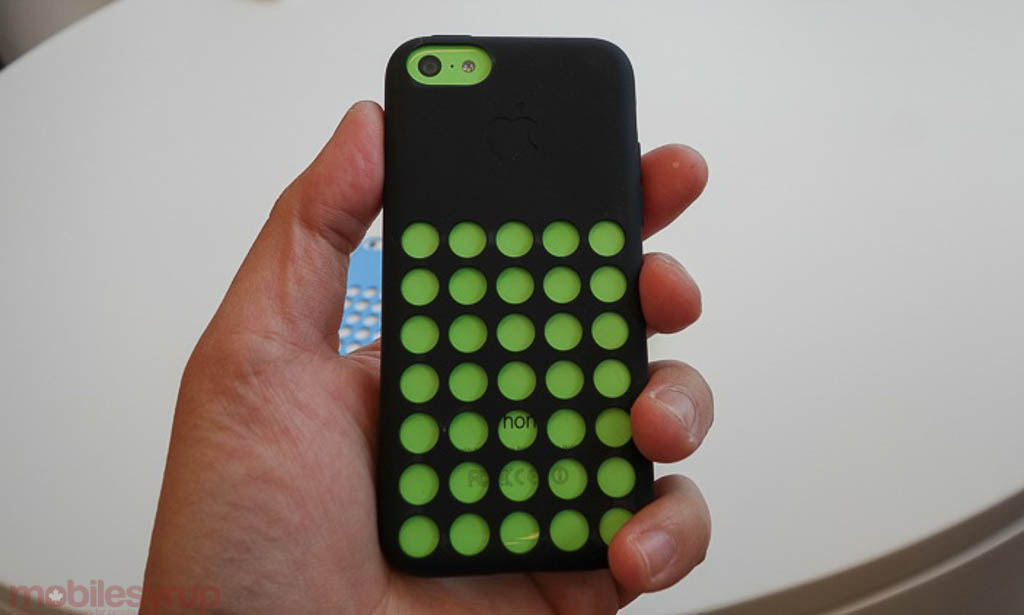
But You’re Not Buying One
Yeah, yeah, we know, you’re not buying one. But millions of people are. Every year, pundits, analysts, fans and detractors deem the new iPhone a failure, and every year they outsell the previous model.
This year, there are two iPhones to dismiss, but there’s no dismissing Apple. Your friends are going to head to an Apple Store to demo the products when they’re released next Friday, and you’ll begin seeing colourful iPhones, or ones with rings around the home buttons, in the weeks to come.
There are certainly things Android does better than iOS, but the delta between the two operating systems is quickly diminishing. As developers release better Android apps, so too will those users come to appreciate some of iOS 7’s massive usability improvements.
iOS 7 still doesn’t expose the file system, nor can you plug in your iPhone and drag music through Explorer. The iPhone still doesn’t have a massive screen or a removable battery, and it will never, ever have a microSD slot (but neither will a Nexus phone). Apple’s Notification Center, even after its iOS 7 makeover, doesn’t come close to Android’s. But iOS and the iPhone continues to entice users by iterating on designs, features and, yes, experiences that people deeply care about. Android manufacturers like HTC and Motorola have taken this to heart and found critical, if not commercial, success by focusing on improving core user experiences, not just specs.
I still stand by the notion that the Note 3 is this year’s most interesting smartphone, but the iPhone 5S may be this year’s most interesting computer.
[If you missed any of our iPhone 5c and 5S coverage, check it out.]
MobileSyrup may earn a commission from purchases made via our links, which helps fund the journalism we provide free on our website. These links do not influence our editorial content. Support us here.

